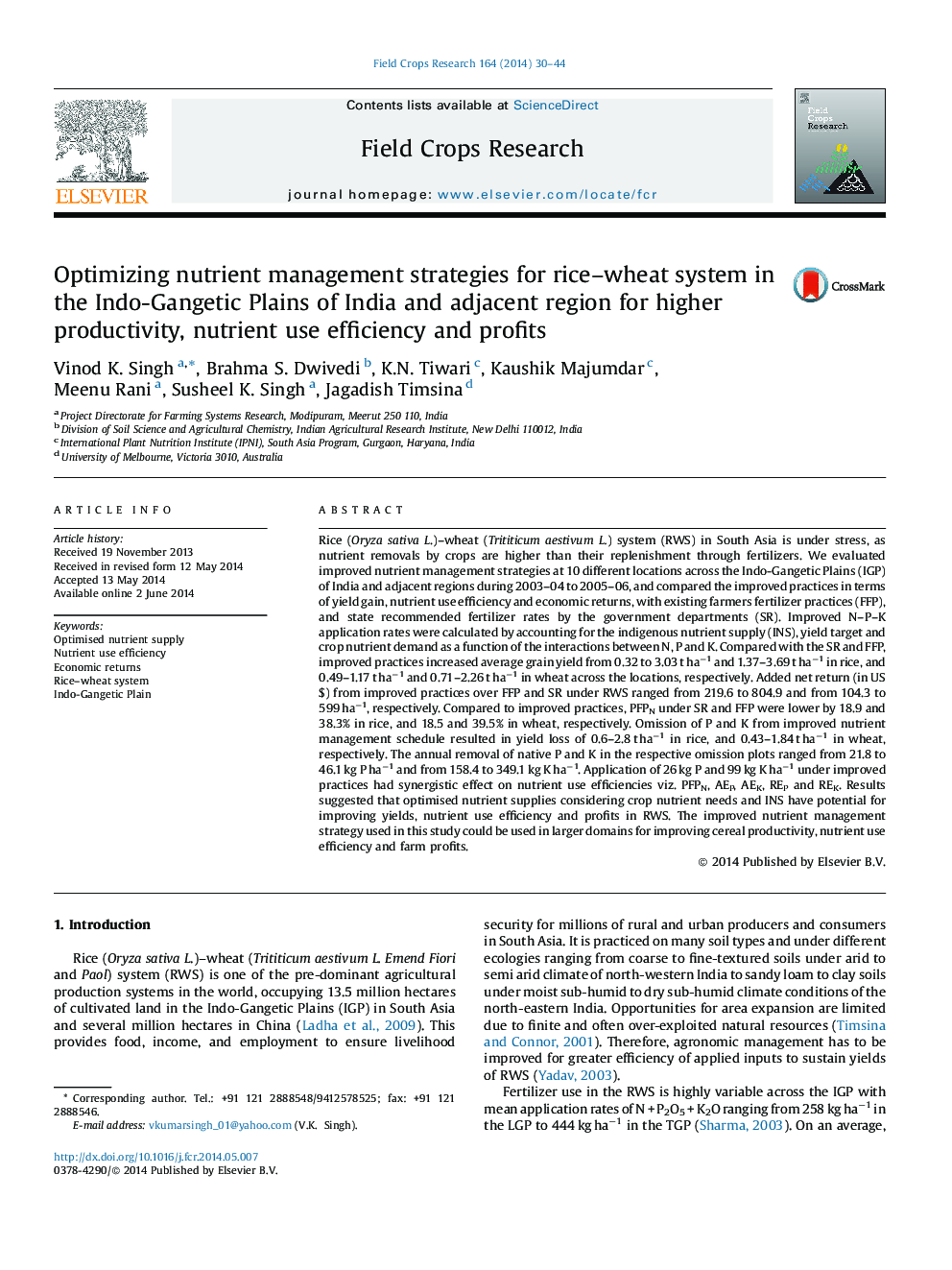| کد مقاله | کد نشریه | سال انتشار | مقاله انگلیسی | نسخه تمام متن |
|---|---|---|---|---|
| 4510083 | 1624699 | 2014 | 15 صفحه PDF | دانلود رایگان |

• We proposed a new approach to optimize nutrient application for rice–wheat cropping system (RWS).
• Experiments at 10 locations in the IGP and adjoining regions for 3 years revealed superiority of optimized nutrient input over prevailing practices.
• Nutrient input based on yield, reciprocal internal efficiencies and indigenous supplies enhanced yields, N and P use efficiencies, and profits.
• Omission of P or K resulted in significant loss of yields and annual net returns.
• Application of fertilizer K enhanced P use efficiency and that of P enhanced K use efficiency in rice and wheat.
ABSTRACTRice (Oryza sativa L.)–wheat (Trititicum aestivum L.) system (RWS) in South Asia is under stress, as nutrient removals by crops are higher than their replenishment through fertilizers. We evaluated improved nutrient management strategies at 10 different locations across the Indo-Gangetic Plains (IGP) of India and adjacent regions during 2003–04 to 2005–06, and compared the improved practices in terms of yield gain, nutrient use efficiency and economic returns, with existing farmers fertilizer practices (FFP), and state recommended fertilizer rates by the government departments (SR). Improved N–P–K application rates were calculated by accounting for the indigenous nutrient supply (INS), yield target and crop nutrient demand as a function of the interactions between N, P and K. Compared with the SR and FFP, improved practices increased average grain yield from 0.32 to 3.03 t ha−1 and 1.37–3.69 t ha−1 in rice, and 0.49–1.17 t ha−1 and 0.71–2.26 t ha−1 in wheat across the locations, respectively. Added net return (in US$) from improved practices over FFP and SR under RWS ranged from 219.6 to 804.9 and from 104.3 to 599 ha−1, respectively. Compared to improved practices, PFPN under SR and FFP were lower by 18.9 and 38.3% in rice, and 18.5 and 39.5% in wheat, respectively. Omission of P and K from improved nutrient management schedule resulted in yield loss of 0.6–2.8 t ha−1 in rice, and 0.43–1.84 t ha−1 in wheat, respectively. The annual removal of native P and K in the respective omission plots ranged from 21.8 to 46.1 kg P ha−1 and from 158.4 to 349.1 kg K ha−1. Application of 26 kg P and 99 kg K ha−1 under improved practices had synergistic effect on nutrient use efficiencies viz. PFPN, AEP, AEK, REP and REK. Results suggested that optimised nutrient supplies considering crop nutrient needs and INS have potential for improving yields, nutrient use efficiency and profits in RWS. The improved nutrient management strategy used in this study could be used in larger domains for improving cereal productivity, nutrient use efficiency and farm profits.
Journal: Field Crops Research - Volume 164, 1 August 2014, Pages 30–44